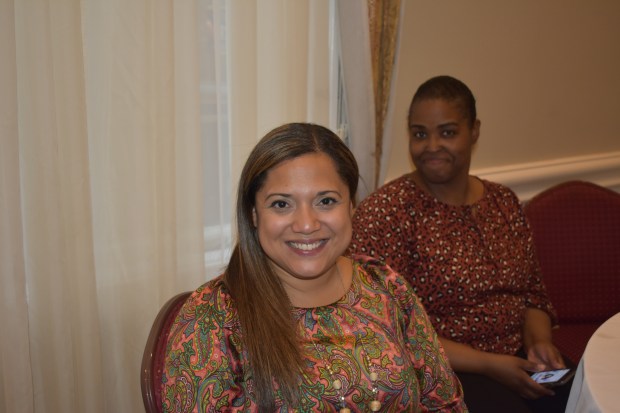“Until I went to college, I never had a teacher who looked anything like me,” Bridgeport Education Association Vice President Ana Batista, who is Latina, told nearly 60 educators gathered for a fall social hosted jointly by BEA and CEA.
Her fellow teachers—most of them men and women of color—nodded in understanding.

Fairfield Spanish teacher Nayla Seara and Waterbury school librarian Charlene Brown share an interest in recognizing and addressing bias.
“It’s important for all of us to get together and become more involved,” Batista said. “We need to be active in our teachers association—our professional organization—which is such an advocate for us and for our students.”
The fall social drew teachers from throughout Fairfield and New Haven counties, many of whom were participating in a union event for the very first time, despite being longtime educators.
One of those first-timers was 16-year veteran Rajinder Khazanchi, who teaches physics at Westhill High School in Stamford.
“I have never attended a CEA event before,” he said. “Many times we, as teachers, spend our days at school and then go straight home. I appreciate the social opportunity this provides.”
Nayla Seara came to network as well. For the past five or six years, the Warde High School Spanish teacher has been active in Fairfield Warde Voices for Equity, a school-based group that includes teachers, parents, and students.
“I’m here to connect with teachers from other districts who may be active in equity groups or are interested in the same issues,” Seara explained, adding that Voices for Equity hosts forums, writing events, and other activities that amplify students’ voices with the goal of breaking down barriers in their schools and communities. “We have had two major conferences on implicit bias.”
Implicit bias was the subject of an interactive presentation led by CEA Regional Organizer Herman Whitter at the Bridgeport fall social. Through candid conversations and activities, Whitter guided teachers in exploring the many filters through which we see those in our school community, and how those filters—culture, socioeconomic status, race, gender, political party, and even birth order—can shape our perceptions of students and colleagues, as well as their perceptions of us.
 Bridgeport school social worker Ana Menjiver (front, right) appreciates hearing the diverse perspectives of fellow educators.
Bridgeport school social worker Ana Menjiver (front, right) appreciates hearing the diverse perspectives of fellow educators.
Sometimes even the most well-intentioned remarks—such as a teacher’s assurance that “I don’t see color”—can be misinterpreted, Whitter explained, sharing the story of a student whose reaction was, “If you don’t see color, then you don’t see me.”
“This is a great event, and I’m always looking for ways to get more involved in my profession and my association,” said Waterbury’s Duggan Elementary School librarian Charlene Brown, who came to education after a career as an accountant. “I like to talk with other professionals about how to raise awareness of social bias and break through it.”
Ana Menjiver, a social worker at Bridgeport’s Harding High School, agreed. “I’m here to learn. I’m interested in the data—how many minority teachers do we have here in Connecticut, and what are we doing to recruit more?”
Learn more about CEA’s efforts to bring more people of color into the teaching profession.







